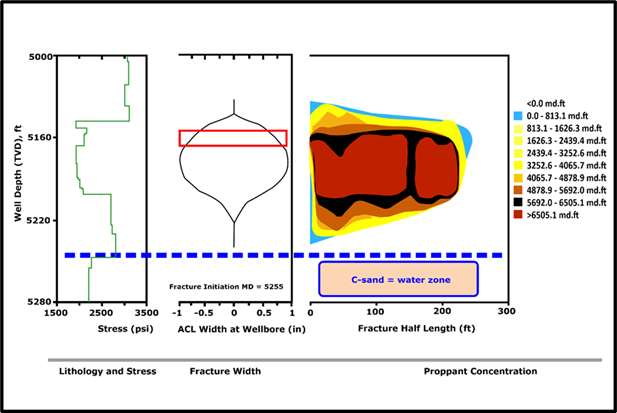An Integrated Analysis for Post Hydraulic Fracturing Production Forecast in Conventional Oil Sand Reservoir
Abstract
Hydraulic fracturing is one of the stimulation treatment in oil and gas well by creating a fractured through a proppant injection to the formation. A most critical problem in the actual oil and gas industry is that the fracturing engineers could not forecast approximately post-production performance after fracturing the job, which is a severe problem. This problem phenomenon has occurred in some cases and significantly impacts production such as oversizing or lower sizing of pumping rate setting. Integrated analysis for post job hydraulic fracturing production based on the geometry model iteration and Productivity Index (PI) comparison in the conventional oil sand reservoir is simply a method to analyze and forecast approximately incremental production performance. The fractured software generates a fractured geometry model that considers half-length of fractured parameters, width in front of perforation, average width, fractured height, and pressure net. Then we compare the Productivity Index's prediction value through the method of Cinco-Ley, Samaniego and Dominguez. A case study in the well of TM#2 (conventional oil sand reservoir) was conducted as the comprehensive study to provide the data and proceed analysis for production forecast. We found that the geometry model and iteration of PKN 2D method generated a small fractured geometry model compare to fracCADE software. The cooperation between PKN 2D method and Cinco-Ley, Samaniego, and Dominguez concept successfully predict post-production forecast. This concept could be proposed as a quick look measurement for production scenarios to overcome pump sizing.
Full text article
References
Afdhol, M. K., Erfando, T., Hidayat, F., Hasibuan, M. Y., & Regina, S. (2020). The Prospect of Electrical Enhanced Oil Recovery for Heavy Oil: A Review. Journal of Earth Energy Engineering, 8(2), 73–94. https://doi.org/10.25299/jeee.2019.4874 DOI: https://doi.org/10.25299/jeee.2019.4874
Annas, P. . (2005). Kerja Ulang Stimulasi–Hydraulic Fracturing. Jurusan Teknik Perminyakan, Universitas Pembangunan Nasional “Veteran” Yogyakarta, Indonesia.
Beggs, H. D. (1991). Production optimization using nodal analysis.
Economides at al. (1990). Reservoir Stimulation Handbook. Association of Environmental & Engineering Geologists.
Economides, M. J., & Nolte, K. G. (2000). Reservoir Stimulation (3rd ed.). Wiley.
Faisal, F. (2015). Post Job Report Hydraulic Fracturing Well X.
Ferizal, F. H., Netzhanova, A. A., Lee, J., Bae, W., Am, S., & Gunadi, T. A. (2013, June 11). Revitalizing Indonesia’s Potential for Oil Production: The Study of Electromagnetically Heated Gravel Packs for Steam-produced Heavy Oil Reservoirs. SPE Heavy Oil Conference-Canada. https://doi.org/10.2118/165508-MS DOI: https://doi.org/10.2118/165508-MS
Ghosh, S., Busetti, S., & Slatt, R. M. (2019). Analysis and prediction of stimulated reservoir volumes though hydraulic fracturing: Examples from western Arkoma Basin. Journal of Petroleum Science and Engineering, 182, 106338. https://doi.org/10.1016/j.petrol.2019.106338 DOI: https://doi.org/10.1016/j.petrol.2019.106338
Hidayat, F., & Abdurrahman, M. (2018). A Prospective Method to Increase Oil Recovery in Waxy-Shallow Reservoir. IOP Conference Series: Materials Science and Engineering, 306(1). https://doi.org/10.1088/1757-899X/306/1/012040 DOI: https://doi.org/10.1088/1757-899X/306/1/012040
Kovalyshen, Y., & Detournay, E. (2010). A reexamination of the classical PKN model of hydraulic fracture. Transport in Porous Media, 81(2), 317–339. https://doi.org/10.1007/s11242-009-9403-4 DOI: https://doi.org/10.1007/s11242-009-9403-4
Kusumastuti, I., Erfando, T., & Hidayat, F. (2019). Effects of Various Steam Flooding Injection Patterns and Steam Quality to Recovery Factor. Journal of Earth Energy Engineering, 8(1), 33–39. https://doi.org/10.25299/jeee.2019.vol8(1).2909 DOI: https://doi.org/10.25299/jeee.2019.vol8(1).2909
Liu, P., Zhao, L., Luo, Z., Li, N., & Xu, M. (2013, June). Predicting Productivity of Hydraulic Fracturing with Pre-Pad Acid. 47th U.S. Rock Mechanics/Geomechanics Symposium.
Melysa, R. (2016). Prediksi Kinerja Steamflood Dengan Metode Myhill-Stegemeier dan Gomaa di Area R Duri Steamflood (DSF). Journal of Earth Energy Engineering, 5(2), 44–56. https://doi.org/10.22549/jeee.v5i2.478 DOI: https://doi.org/10.22549/jeee.v5i2.478
Montgomery, C. T., & Smith, M. B. (2010). Hydraulic fracturing: History of an enduring technology. Journal of Petroleum Technology, 62(12), 26–32. https://doi.org/10.2118/1210-0026-jpt DOI: https://doi.org/10.2118/1210-0026-JPT
Rahman, M. M., & Rahman, M. K. (2010). A review of hydraulic fracture models and development of an improved pseudo-3D model for stimulating tight oil/gas sand. Energy Sources, Part A: Recovery, Utilization and Environmental Effects, 32(15), 1416–1436. https://doi.org/10.1080/15567030903060523 DOI: https://doi.org/10.1080/15567030903060523
Wibowo. (2005). Diktat Kuliah Teknik Produksi II. Jurusan Teknik Perminyakan, Univeritas Pembangunan Nasional “Veteran” Yogyakarta, Indonesia.
Authors
This is an open access journal which means that all content is freely available without charge to the user or his/her institution. The copyright in the text of individual articles (including research articles, opinion articles, and abstracts) is the property of their respective authors, subject to a Creative Commons CC-BY-SA licence granted to all others. JEEE allows the author(s) to hold the copyright without restrictions and allows the author to retain publishing rights without restrictions.




